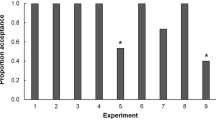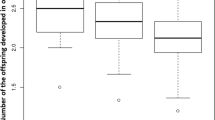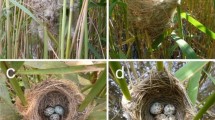Abstract
The connectivity of a surface (structural complexity) can have a significant effect on the host finding behavior and efficiency of parasitoids that must search the surface for hosts. We investigated whether the generalist egg parasitoid, Trichogramma nubilale Ertle and Davis (Hymenoptera: Trichogrammatidae), found hosts more efficiently on simple or complex surfaces, and evaluated the potential genetic basis of this variation using a full-sib/ half-sib mating design. Of the egg masses parasitized 63.8% were on the simple surface while only 36.2% were on the complex surface. There was significant repeatable variation among females (repeatability =0.59, n=19 females), with some better at finding hosts on simple surfaces and others better on complex surfaces. These results reinforce previous findings that structural complexity can affect host finding by parasitoids. The additive genetic variance in this character was not significant (sires =23, dams =46, progeny =92), but the maternal plus dominance variance (V m+1/2V d) was significant (P<0.036), and accounted for 48.8% of the total phenotypic variance. The maternal or dominance effects could have complex evolutionary consequences, causing the evolution of other foraging traits to be retarded, to overshoot their optima, or to have complex selective regimes. Thus, the evolution of foraging behavior may depend strongly on the mechanistic details of foraging behavior, including the effects of structural complexity on host finding.


Similar content being viewed by others
References
Andow DA, Prokrym DR (1990) Plant structural complexity and host-finding by a parasitoid. Oecologia 82:162–165
Banks CJ (1957) The behavior of individual coccinellid larvae on plants. Br J Anim Behav 5:12–24
Becker WA (1992) Manual of quantitative genetics. Academic Enterprises, Pullman, Wash.
Bottrell D, Barbosa P, Gould F (1998) Manipulating natural enemies by plant variety selection and modification: a realistic strategy? Annu Rev Entomol 43:347–367
Byogo TP, Becker WA (1963) Exact confidence intervals for genetic heritability estimated from paternal half-sib correlations. Biometrics 19:494–496
Chassain C (1988) Reproduction et comportements d'infestion des hôtes chez les trichogrammes: Facteurs de variations génétiques et épigénétiques. Ph.D. Thesis, University of Lyon
Collins RD, Gargesh RN, Maltby AD, Roggero RJ, Tourtellot MK, Bell WJ (1994) Innate control of local search behaviour in the house fly, Musca domestica. Physiol Entomol 19:165–172
De Belle JS, Sokolowski MB (1987) Heredity of rover/sitter: alternative foraging strategies of Drosophila melanogaster larvae. Heredity 59:73–83
De Belle JS, Sokolowski MB (1989) Rover/sitter foraging behavior in Drosophila melanogaster: Genetic localization to chromosome 2L using compound autosomes. J Insect Behav 2:291–299
De Belle JS, Hillider AJ, Sokolowski MB (1989) Genetic localization of foraging (for): a major gene for larval behavior in Drosophila melanogaster. Genetics 123:157–163
De Belle JS, Sokolowski MB, Hilliker AJ (1993) Genetic analysis of the foraging microregion of Drosophila melanogaster. Genome 36:94–101
Eigenbrode SD, Espelie KE (1995) Effects of plant epicuticular lipids on insect herbivores. Annu Rev Entomol 40:171–194
Frazer BD, McGregor RR (1994) Searching behaviour of adult female coccinellidae (Coleoptera) on stem and leaf models. Can Entomol 126:389–399
Gaugler R, Campbell JF, McGuire TR (1989) Selection for host-finding in Steinernema feltiae. J Invert Pathol 54:363–372
Kareiva PM, Sahakian R (1990) Tritrophic effects of a simple architectural mutation in pea plants. Nature 345:433–434
Kirkpatrick M, Lande R (1989) The evolution of maternal characters. Evolution 43:485–503
Lawton JH (1983) Plant architecture and the diversity of phytophagous insects. Annu Rev Entomol 28:23–39
Legrand AI (1999) Effects of plant morphological complexity on the efficacy and efficiency of adult Coccinella septempunctata L. as a predator of the pea aphid. Ph. D. Dissertation, University of Maryland, College Park
Limberg H, Pak GA (1991) Genetic variation in walking behaviour of the egg parasite Trichogramma. In: Bigler F (ed) Fifth Workshop of the IOBC Global Working Group. Quality control of mass reared arthropods. IOBC, Wageningen, pp 47–55
Lukianchuk JL, Smith SM (1997) Influence of plant structural complexity on the foraging success of Trichogramma minutum: a comparison of search on artificial and foliage models. Entomol Exp Appl 84:221–228
Margolies DC, Cox TS (1992) Quantitative genetics applied to haplodiploid insects and mites. In: Wrensch DL, Ebbert MA (eds) The evolution and diversity of sex ratio. Chapman and Hall, New York, pp 548–559
Mitchell-Olds T, Bergelson J (1990) Statistical genetics of an annual plant, Impatiens capensis. I. Genetic basis of quantitative variation. Genetics 124:407–415
Olson DM, Andow DA (2002) Inheritance of an oviposition behavior by an egg parasitoid. Heredity 88:437–443
Pereira HS, Sokolowski MB (1993) Mutations in the larval foraging gene affect adult locomotory behavior after feeding in Drosophila melanogaster. Proc Natl Acad Sci USA 90:5044–5046
Pereira HS, MacDonald DE, Hilliker AJ, Sokolowski MB (1995) Chaser (Csr), a new gene affecting larval foraging behavior in Drosophila melanogaster. Genetics 141:263–270
Pimentel D (1961) Am evaluation of insect resistance in broccoli, brussels sprouts, cabbage, collards and kale. J Econ Entomol 54:156–158
Platenkamp GA, Shaw RG (1993) Environmental and genetic maternal effects on seed characters in Nemophila menziesii. Evolution 47:540–555
SAS (1996) SAS System for Windows Release 6.12 TS level 0020. SAS Institute, Cary, N.C.
Scheiner SM (1993) Genetics and evolution of phenotypic plasticity. Annu Rev Ecol Syst 23:35–68
Schmidt JM (1991) The role of physical factors in tritrophic interactions. Redia 74 Appendix:43–93
Shaw RG, Byers D (1998) Genetics of maternal and paternal effects. In: Mousseau TA, Fox CW (eds) Maternal effects as adaptations. Oxford University Press, New York, pp 97–111
Sokolowski MB, Bauer SJ (1989) Genetic analyses of pupation distance in Drosophila melanogaster. Heredity 62:177–183
Sokolowski MB, Pereira HS, Hughes K (1997) Evolution of foraging behavior in Drosophila by density-dependent selection. Proc Natl Acad Sci USA 94:7373–7377
Wajnberg E (1991) Quality control of mass reared arthropods: a genetical and statistical approach. In: Bigler F (ed) Fifth Workshop of the IOBC Global Working Group. Quality control of mass reared arthropods. IOBC, Wageningen, pp 15–25
West-Eberhard MJ (1989) Phenotypic plasticity and the origins of diversity. Annu Rev Ecol Syst 20:249–278
Wu CFJ (1986) Jackknife, bootstrap, and other resampling methods in regression analysis. Ann Stat 14:1261–1295
Acknowledgements
We thank Vid Bhatker for his assistance and insights in collecting these data and David Prokrym for early discussions on the experimental design. We thank B. Rector and two anonymous reviewers for comments on this paper. This work was supported by USDA North Central Regional Research Project 205, Ecology and Management of Stalk Boring Insects of Corn and NSF DMS-0083468.
Author information
Authors and Affiliations
Corresponding author
Rights and permissions
About this article
Cite this article
Andow, D.A., Olson, D.M. Inheritance of host finding ability on structurally complex surfaces. Oecologia 136, 324–328 (2003). https://doi.org/10.1007/s00442-003-1262-z
Received:
Accepted:
Published:
Issue Date:
DOI: https://doi.org/10.1007/s00442-003-1262-z




